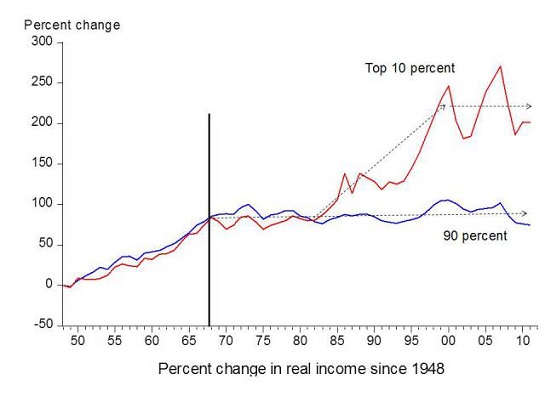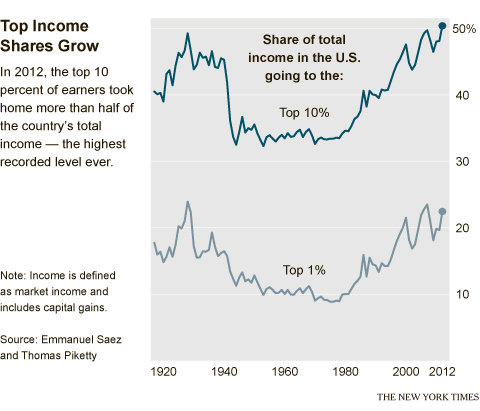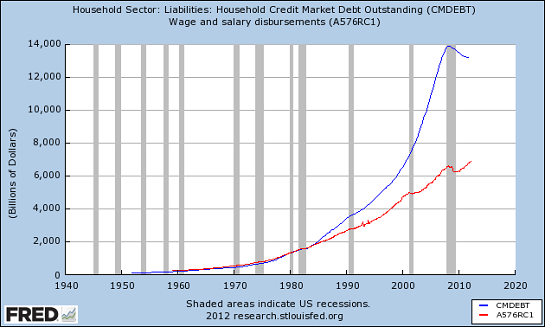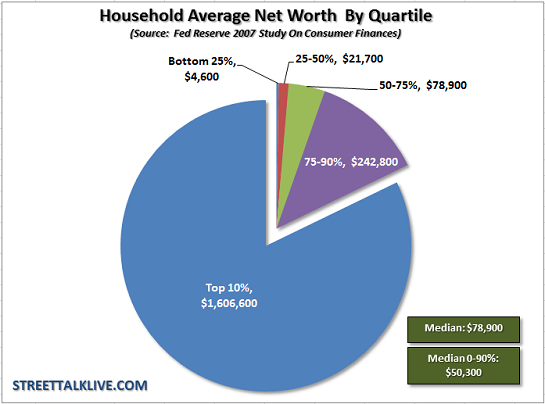The “middle class” has atrophied into
the 10% of households just below the top 10%.
The truth is painfully obvious: a middle
class lifestyle is unaffordable to all but the top 20%. This
reality is destabilizing to the current arrangement, i.e. debt-based
consumerism a.k.a. neofeudal state-cartel capitalism, so it is
actively suppressed by the officially sanctioned narrative: that
middle class status is attainable by almost every household with two
earners (a mere $50,000 annual household income makes one middle
class) and middle class wealth is increasing.
It’s not that difficult to define a middle
class lifestyle: just list what was taken for granted in the
postwar era of widespread prosperity circa the 1960s, four decades
ago.
In What
Does It Take To Be Middle Class? (December 5, 2013), I
listed 10 basic “threshold” attributes and two somewhat higher
thresholds for membership in the middle class:
1. Meaningful healthcare insurance (i.e. not
phantom “insurance” with deductibles that cost thousands of
dollars a year that offers no non-catastrophic care at all)
2. Significant equity (25%-50%) in a home
3. Income/expenses that enable the household to
save at least 6% of its income
4. Significant retirement funds: 401Ks, IRAs,
etc.
5. The ability to service all debt and expenses
over the medium-term if one of the primary household wage-earners
lose their job
6. Reliable vehicles for each wage-earner
7. The household does not rely on government
transfers to maintain its lifestyle
8. Non-paper, non-real estate assets such as
family heirlooms, precious metals, tools, etc. that can be
transferred to the next generation, i.e. generational wealth
9. Ability to invest in offspring (education,
extracurricular clubs/training, etc.)
10. Leisure time devoted to the maintenance of
physical/spiritual/mental fitness
The higher thresholds:
11. Continual accumulation of human and social
capital (new skills, markets for one’s services, etc.)
And the money shot:
12. Family ownership of income-producing assets
such as rental properties, bonds, etc.
The key point of these thresholds is that
propping up a precarious illusion of consumption and status
signifiers does not qualify as middle class. To qualify as
middle class, the household must actually own/control wealth that
won’t vanish if the investment bubble du jour pops,
and won’t be wiped out by a layoff, college costs or a medical
emergency.
In Chris Sullin’s phrase, “They
should be focusing resources on the next generation and passing on
Generational Wealth” as opposed to “keeping up
appearances” via aspirational consumption financed with debt.
I
then added up the real cost of these minimum thresholds and arrived
at a minimum of $106,000 annual household income–double the median
household income in the U.S. According
to Census
Bureau data, only the top 20% earn this level of income.
Here is a chart of the real income of the lower
90% and the top 10%, which by definition cannot be “middle
class”:

The top 10% takes home 51% of all household
income:

This suggests that the “middle class”
has atrophied into the 10% of households just below the top
10%. Households in the “bottom 80%” are lacking
essential attributes of a middle class lifestyle that were once
affordable on a much more modest income.
Note that this $100,000+ household income has
no budget for college costs, lavish vacations, boats, weekends spent
skiing, etc., nor does it budget for luxury vehicles, SUVs, oversized
pickup trucks or private schooling. Savings are modest, along with
living expenses and retirement contributions. This is a
barebones middle class budget.
So how have we maintained an increasingly
unaffordable lifestyle? With debt: Wages have risen modestly
while debt has increased enormously.

As
I have described many times, the Federal Reserve’s “solution”
to the widening gap between income and expenses was to financialize
the middle class’s primary asset: the home. I
have explained this in depth: The
Fed’s Solution to Income Stagnation: Make Everyone a
Speculator (January 24, 2014)
But
turning everyone into a speculator via financialization had an
unintended consequence: widening wealth inequality. It
turns out most people are poor speculators, believing “this time
it’s different” again and again. In addition, financialization
favors those with the most capital: this is the essential take-away
from Thomas Piketty’s book Capital
in the Twenty-First Century.
The
conclusion is inescapable: What’s
the Primary Cause of Wealth Inequality? Financialization (March
24, 2014).
As a consequence, net worth (i.e. ownership of
assets and wealth) of middle income households has been reduced to a
sliver:

The widening wealth gap cannot be entirely
explained away as the result of some innate force of capitalism; the
rich have gotten richer as the direct result of central state/central
bank policies introduced since the heyday of the middle class forty
years ago.
So where does this leave us? To
answer that, we need to examine the systemic causes of the higher
costs and reliance on speculative bubbles that have eaten the middle
class alive. We’ll address those tomorrow in Part 2.
No comments:
Post a Comment